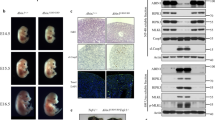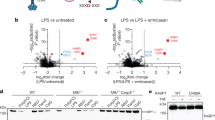Abstract
FADD is a common adaptor shared by several death receptors for signalling apoptosis through recruitment and activation of caspase 8 (refs 1–3). Death receptors are essential for immune homeostasis, but dispensable during embryogenesis. Surprisingly, Fadd−/− mice die in utero4,5 and conditional deletion of FADD leads to impaired lymphocyte proliferation6,7. How FADD regulates embryogenesis and lymphocyte responses has been a long-standing enigma. FADD could directly bind to RIP1 (also known as RIPK1), a serine/threonine kinase that mediates both necrosis and NF-κB activation. Here we show that Fadd−/− embryos contain raised levels of RIP1 and exhibit massive necrosis. To investigate a potential in vivo functional interaction between RIP1 and FADD, null alleles of RIP1 were crossed into Fadd−/− mice. Notably, RIP1 deficiency allowed normal embryogenesis of Fadd−/− mice. Conversely, the developmental defect of Rip1−/− lymphocytes was partially corrected by FADD deletion. Furthermore, RIP1 deficiency fully restored normal proliferation in Fadd−/− T cells but not in Fadd−/− B cells. Fadd−/−Rip1−/− double-knockout T cells are resistant to death induced by Fas or TNF-α and show reduced NF-κB activity. Therefore, our data demonstrate an unexpected cell-type-specific interplay between FADD and RIP1, which is critical for the regulation of apoptosis and necrosis during embryogenesis and lymphocyte function.
This is a preview of subscription content, access via your institution
Access options
Subscribe to this journal
Receive 51 print issues and online access
$199.00 per year
only $3.90 per issue
Buy this article
- Purchase on Springer Link
- Instant access to full article PDF
Prices may be subject to local taxes which are calculated during checkout



Similar content being viewed by others
References
Boldin, M. P. et al. A novel protein that interacts with the death domain of Fas/APO1 contains a sequence motif related to the death domain. J. Biol. Chem. 270, 7795–7798 (1995)
Chinnaiyan, A. M., O’Rourke, K., Tewari, M. & Dixit, V. M. FADD, a novel death domain-containing protein, interacts with the death domain of Fas and initiates apoptosis. Cell 81, 505–512 (1995)
Zhang, J. & Winoto, A. A mouse Fas-associated protein with homology to the human Mort1/FADD protein is essential for Fas-induced apoptosis. Mol. Cell. Biol. 16, 2756–2763 (1996)
Zhang, J., Cado, D., Chen, A., Kabra, N. H. & Winoto, A. Fas-mediated apoptosis and activation-induced T-cell proliferation are defective in mice lacking FADD/Mort1. Nature 392, 296–300 (1998)
Yeh, W.-C. et al. FADD: essential for embryo development and signaling from some, but not all, inducers of apoptosis. Science 279, 1954–1958 (1998)
Zhang, Y. et al. Conditional Fas-associated death domain protein (FADD):GFP knockout mice reveal FADD is dispensable in thymic development but essential in peripheral T cell homeostasis. J. Immunol. 175, 3033–3044 (2005)
Imtiyaz, H. Z. et al. The Fas-associated death domain protein is required in apoptosis and TLR-induced proliferative responses in B cells. J. Immunol. 176, 6852–6861 (2006)
Nagata, S. Apoptosis by death factor. Cell 88, 355–365 (1997)
Boldin, M. P., Goncharov, T. M., Goltsev, Y. V. & Wallach, D. Involvement of MACH, a novel MORT1/FADD-interacting protease, in Fas/APO-1-and TNF receptor-induced cell death. Cell 85, 803–815 (1996)
Muzio, M. et al. FLICE, a novel FADD-homologous ICE/CED-3-like protease, is recruited to the CD95 (Fas/APO-1) death-inducing signaling complex. Cell 85, 817–827 (1996)
Holler, N. et al. Fas triggers an alternative, caspase-8-independent cell death pathway using the kinase RIP as effector molecule. Nature Immunol. 1, 489–495 (2000)
Chan, F. K.-M. et al. A role for tumor necrosis factor receptor-2 and receptor-interacting protein in programmed necrosis and antiviral responses. J. Biol. Chem. 278, 51613–51621 (2003)
Cho, Y. S. et al. Phosphorylation-driven assembly of the RIP1–RIP3 complex regulates programmed necrosis and virus-induced inflammation. Cell 137, 1112–1123 (2009)
He, S. et al. Receptor interacting protein kinase-3 determines cellular necrotic response to TNF-α. Cell 137, 1100–1111 (2009)
Zhang, D. W. et al. RIP3, an energy metabolism regulator that switches TNF-induced cell death from apoptosis to necrosis. Science 325, 332–336 (2009)
Kelliher, M. A. et al. The death domain kinase RIP mediates the TNF-induced NF-κB signal. Immunity 8, 297–303 (1998)
Cusson, N., Oikemus, S., Kilpatrick, E. D., Cunningham, L. & Kelliher, M. The death domain kinase RIP protects thymocytes from tumor necrosis factor receptor type 2-induced cell death. J. Exp. Med. 196, 15–26 (2002)
Shen, H. M. et al. Essential roles of receptor-interacting protein and TRAF2 in oxidative stress-induced cell death. Mol. Cell. Biol. 24, 5914–5922 (2004)
Degterev, A. et al. Chemical inhibitor of nonapoptotic cell death with therapeutic potential for ischemic brain injury. Nature Chem. Biol. 1, 112–119 (2005)
Rosenberg, S., Zhang, H. & Zhang, J. FADD deficiency impairs early hematopoiesis in the bone marrow. J. Immunol. 186, 203–213 (2011)
Varfolomeev, E. E. et al. Targeted disruption of the mouse caspase 8 gene ablates cell death induction by the TNF receptors, Fas/Apo1, and DR3 and is lethal prenatally. Immunity 9, 267–276 (1998)
Ch’en, I. L. et al. Antigen-mediated T cell expansion regulated by parallel pathways of death. Proc. Natl Acad. Sci. USA 105, 17463–17468 (2008)
Osborn, S. L. et al. Fas-associated death domain (FADD) is a negative regulator of T-cell receptor-mediated necroptosis. Proc. Natl Acad. Sci. USA 107, 13034–13039 (2010)
Acknowledgements
We thank M. Kelliher for providing Rip1+/− mice, S. Rosenberg, S. Waggoner, R. Welsh, V. Vanguri and Y. Liu for advice and technical assistance, X. Lin for discussions and suggestions, C. E. Calkins and K. Reinersmann for critical reading of the manuscript, and Z. Zhong for help with histology analysis. This study was supported in part by NIH grants CA95454, AI083915 and AI076788 awarded to J.Z. and AI083497 awarded to F.K.-M.C.; a W. W. Smith Charitable Trust grant, a TJU Enhancement grant, and a CONCERN Foundation grant awarded to J.Z. F.K.-M.C. is a member of the UMass DERC (DK32520) and is also supported in part by an NIH grant (AI017672).
Author information
Authors and Affiliations
Contributions
J.Z. conceived and initiated the project. J.Z., F.K.-M.C. and H.Z. planned the experiments. All authors performed and analysed the experiments. J.Z. and F.K.-M.C. wrote the manuscript with contribution from H.Z.
Corresponding authors
Ethics declarations
Competing interests
The authors declare no competing financial interests.
Supplementary information
Supplementary Information
The file contains Supplementary Figures 1-8 with legends and Supplementary Table 1. (PDF 3617 kb)
Rights and permissions
About this article
Cite this article
Zhang, H., Zhou, X., McQuade, T. et al. Functional complementation between FADD and RIP1 in embryos and lymphocytes. Nature 471, 373–376 (2011). https://doi.org/10.1038/nature09878
Received:
Accepted:
Published:
Issue Date:
DOI: https://doi.org/10.1038/nature09878
This article is cited by
-
Caspase cleavage of RIPK3 after Asp333 is dispensable for mouse embryogenesis
Cell Death & Differentiation (2024)
-
RIPK1 polymorphisms and expression levels: impact on genetic susceptibility and clinical outcome of epithelial ovarian cancer
Cancer Cell International (2023)
-
Oxidative stress induces mitochondrial iron overload and ferroptotic cell death
Scientific Reports (2023)
-
Harnessing TRAIL-induced cell death for cancer therapy: a long walk with thrilling discoveries
Cell Death & Differentiation (2023)
-
Inflammatory cell death, PANoptosis, screen identifies host factors in coronavirus innate immune response as therapeutic targets
Communications Biology (2023)
Comments
By submitting a comment you agree to abide by our Terms and Community Guidelines. If you find something abusive or that does not comply with our terms or guidelines please flag it as inappropriate.



